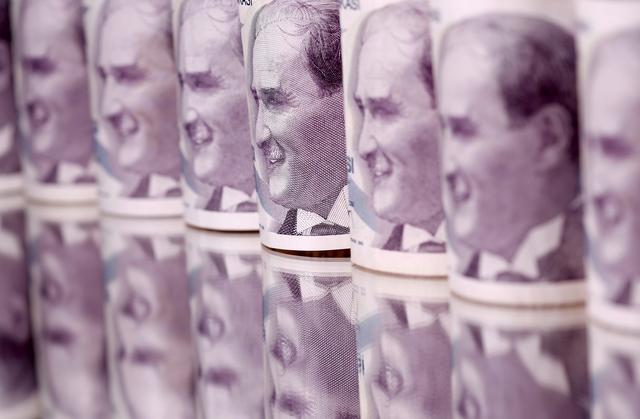
ISTANBUL (Reuters) – Turkey’s lira slid 15 percent to a near all-time low on Monday after President Tayyip Erdogan’s shock weekend ousting of a hawkish central bank governor sparked fears of a reversal of recent rate hikes, before clawing back some overnight losses.
The appointment of Sahap Kavcioglu, a former banker and ruling party lawmaker, in the early hours on Saturday marked the third time since mid-2019 that Erdogan has abruptly fired a central bank chief.
Kavcioglu sought to ease concerns about a sharp selloff in Turkish assets and a pivot from tight to loose policy, telling bank CEOs on Sunday he planned no immediate policy change, a source told Reuters.
The currency tumbled to as weak as 8.4850 versus the dollar, from 7.2185 on Friday, back to levels touched in early November when it reached an intraday record of 8.58.
It recovered about half of those losses after Finance Minister Lutfi Elvan said Turkey would stick to free market rules, reaching 7.76 at 0620 GMT, seven percent weaker from Friday.
Goldman Sachs and others had expected a sharp dive in the lira and Turkish assets given the new governor’s dovish and even unorthodox views, and what was seen as the latest damage to the bank’s credibility amid years of policy interference that has dogged the major emerging market economy.
The weekend overhaul could soon reverse the hawkish steps taken by predecessor Naci Agbal, analysts said, and nudge Turkey toward a balance of payments crisis given its depleted buffer of FX reserves.
Turkey “will be left with two choices, either it pledges to use interest rates to stabilise markets, or it imposes capital controls,” said Per Hammarlund, senior EM strategist at SEB Research.
Finance Minister Elvan said authorities were determined to stick to free-market rules and a free-floating currency regime. He said in a statement the macro policy framework would continue until there is a lasting fall in inflation.
Erdogan fired Agbal two days after a sharp rate hike that was meant to head off inflation of nearly 16 percent and a dipping lira.
In less than five months on the job, Agbal had raised rates by 875 basis points to 19 percent and regained some policy credibility as the lira rallied from its nadir.
Cristian Maggio, a strategist at TD Securities said the overhaul “demonstrates the erratic nature of policy decisions in Turkey, especially with regard to monetary matters (and risks) looser, unorthodox, and eventually mostly pro-growth policies from now on.”
On the call with Turkish bankers, Kavcioglu said current policy would continue and any change would depend on lowering inflation, which he said was the primary goal, the source familiar with the call said.
The central bank did not immediately comment on the call. In a statement on Sunday, Kavcioglu said the bank would focus on permanently lowering inflation, which has been stuck in double digits for most of the last four years.
Kavcioglu said policy meetings will remain on a monthly schedule, suggesting any rate cuts may wait until the next planned meeting on April 15.
A former member of parliament for Erdogan’s AK Party (AKP), Kavcioglu has espoused the unorthodox views shared by the president. He wrote high rates “indirectly cause inflation to rise,” in a newspaper column last month.
WEEKEND OF QUESTIONS
Agbal’s final rate hike was 200 basis-points on Thursday which sparked a more than three percent lira rally.
His hawkish stance dramatically cut Turkey’s CDS risk gauges and started to reverse a years-long trend of funds abandoning local assets.
But after Erdogan ousted Agbal, investors told Reuters they had worked through the weekend to predict how quickly and sharply Kavcioglu might cut rates – and how much the currency would retreat.
Wall Street bank Goldman told clients it was reviewing investment recommendations and predicted a “discontinuous” drop in the lira, and a “front-loaded” rate-cutting cycle.
The overhaul meant capital outflows appeared likely and a rapid adjustment in the current account may be necessary since markets would shy away from funding Turkey’s chronic deficits, it said.
The lira has lost half its value since a 2018 currency crisis.
Additional reporting by Kevin Buckland in Tokyo, Nevzat Devranoglu in Ankara, and Can Sezer and Ali Kucukgocmen in Istanbul; Writing by Jonathan Spicer and Dominic Evans; Editing by Lincoln Feast.




